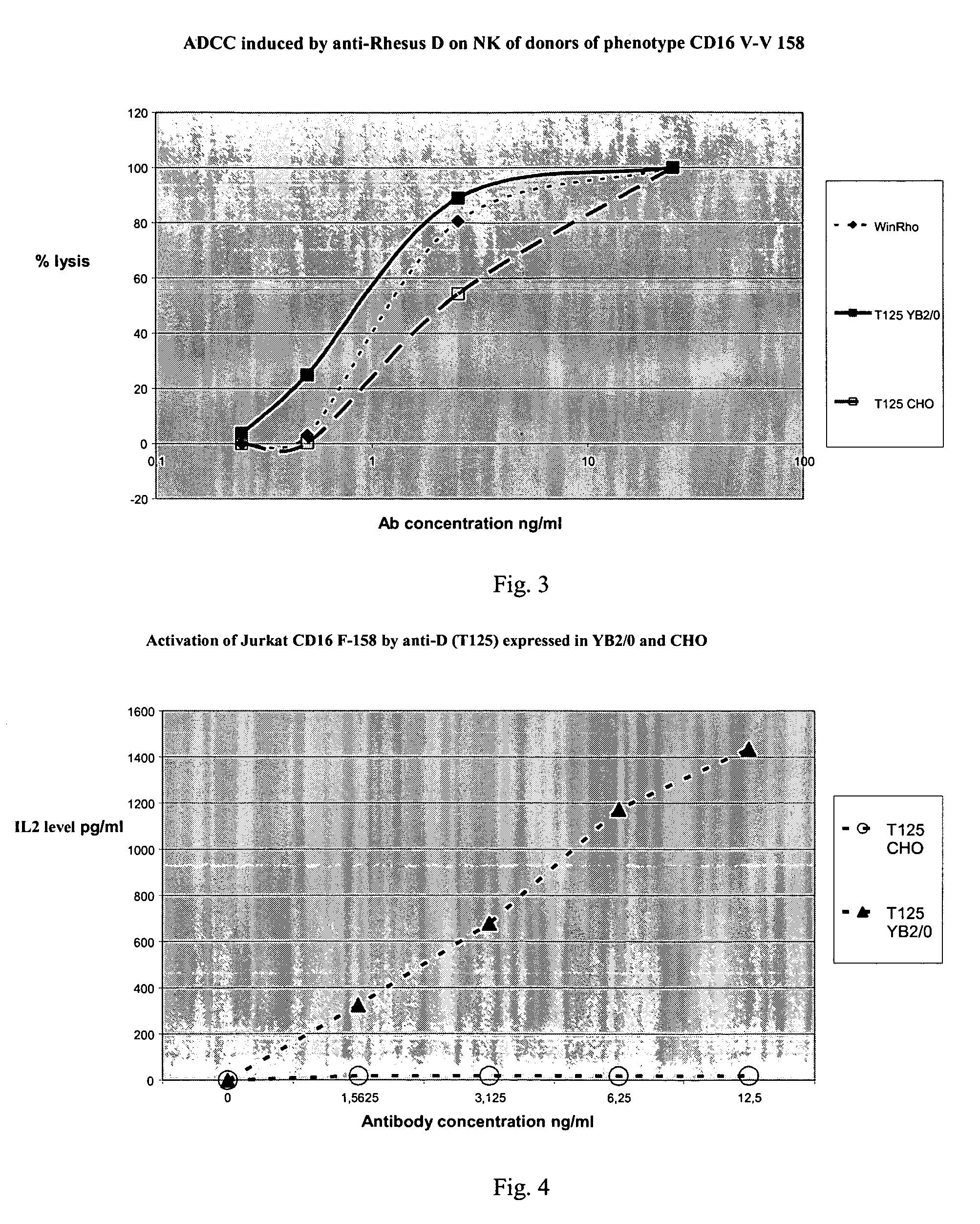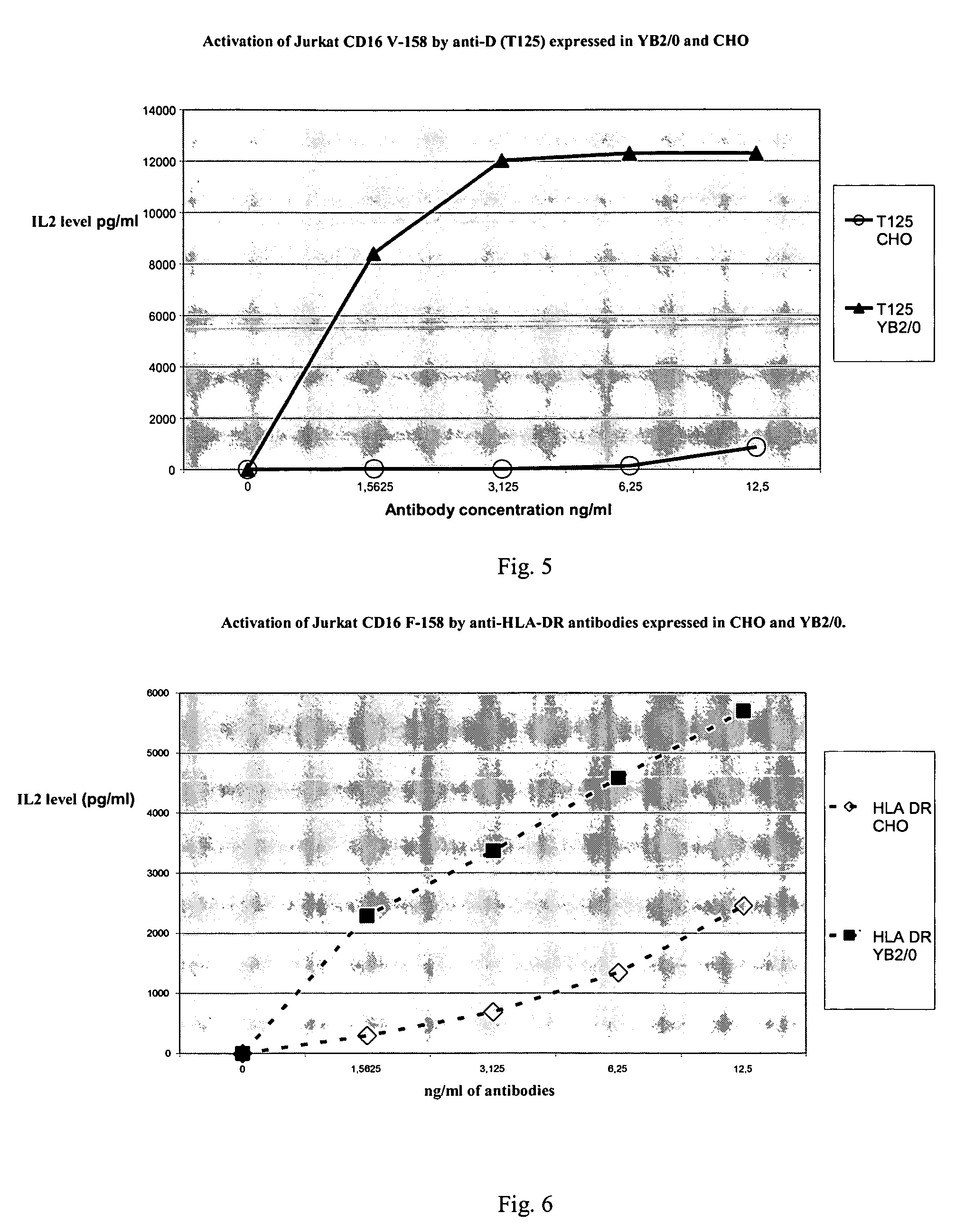Use of ADCC-optimized antibodies for treating low-responder patients
a technology of adcc-optimized antibodies and low-responder patients, which is applied in the direction of antibody medical ingredients, immunological disorders, extracellular fluid disorders, etc., can solve the problems of numerous clinical trials being stopped, monoclonal antibodies not active and/or effective enough, and mixed results obtained in clinical trials. to achieve the effect of increasing the interaction with the fc receptor
- Summary
- Abstract
- Description
- Claims
- Application Information
AI Technical Summary
Benefits of technology
Problems solved by technology
Method used
Image
Examples
example 1
ADCC Activity of the Anti-Rhesus D Monoclonal Antibody R297 Compared with the Polyclonal Anti-D Antibodies on a Group of 107 Blood Donors
[0079]The respective capacities of the anti-Rhesus D R 297 monoclonal antibody and polyclonal anti-D antibodies to lyse erythrocytes in the presence of effector cells of different individual donors are compared (FIG. 1).
[0080]The effector cells come from a group of 107 blood donors. The mononuclear cells (PBMC) are isolated from a blood bag by centrifugation on a Ficoll gradient (Pack Plus Pharmacia). The platelets are removed by centrifugation (190 g, 15 min) and the residual red blood cells are lysed with NH4Cl. The cells are washed and resuspended at 8×107 cells / ml in IMDM. The red blood cells obtained from therapeutic concentrates (group O, Rhesus+) are treated for 10 min with papain (1 mg / ml) then washed three times in a saline buffer and adjusted to a concentration of 4×107 / ml or 2×107 / ml (NK test) in IMDM.
[0081]The test is performed in a pla...
example 2
ADCC Efficacy of the Antibodies Produced in CHO and YB2 / 0 According to the CD16 Polymorphism
[0086]The same sequence encoding a specific IgG1 of the Rhesus D antigen was transfected into CHO and YB2 / 0 cell lines. The antibodies were incubated with positive Rhesus erythrocytes (target cells) and NK cells from 6 different donors (3 FCGR3A-158V homozygotes and 3 FCGR3A-158F homozygotes) previously genotyped for their CD16 phenotype in position 158. The NK cells are isolated using the magnetic bead separation technique (MACS) of Myltenyi. The NK cells are washed and resuspended at 2×107 / ml and / or 6×107 / ml in IMDM. The red blood cells are adjusted to a concentration of 2×107 / ml in IMDM. The Tegeline is replaced by the IMDM. Aside from these modifications, the test is identical to the ADCC test with PBMC.
[0087]The cytotoxic activity of the antibodies on the erythrocytes (ADCC) was evaluated (FIG. 2 and FIG. 3).
[0088]The antibody produced in the CHO line induced a lower lysis than the antib...
example 3
Comparison of the Activation of Homozygous FCGR3A-158F CD16 Jurkat Cells and Homozygous FCGR3A-158F CD16 Jurkat Cells Induced by Anti-Rhesus Antibodies Produced in CHO and YB2 / 0 Respectively: Evaluation of IL2 Production
[0093]This test estimates the capacity of the antibodies to bind to the CD16 receptor (Fc gamma RIII) expressed on the CD16 Jurkat cells and to induce the secretion of IL2.
[0094]The same sequence encoding an IgG1 (T125) specific to the Rhesus D antigen was transfected into the CHO and YB2 / 0 cell lines. The antibodies are incubated with positive Rhesus erythrocytes (target cell) and CD16 Jurkat cells (effector cells). Two types of Jurkat cells were used: 1—cells transfected with the gene encoding an RFc bearing the amino acid phenylalanine F in position 158 (form F), 2—cells transfected with the gene encoding an RFc bearing the amino acid valine V in position 158 (form V). The amount of cytokine (IL2) secreted by the CD16 Jurkat cells was measured by ELISA.
[0095]In a ...
PUM
| Property | Measurement | Unit |
|---|---|---|
| concentration | aaaaa | aaaaa |
| concentration | aaaaa | aaaaa |
| concentrations | aaaaa | aaaaa |
Abstract
Description
Claims
Application Information
 Login to View More
Login to View More - R&D
- Intellectual Property
- Life Sciences
- Materials
- Tech Scout
- Unparalleled Data Quality
- Higher Quality Content
- 60% Fewer Hallucinations
Browse by: Latest US Patents, China's latest patents, Technical Efficacy Thesaurus, Application Domain, Technology Topic, Popular Technical Reports.
© 2025 PatSnap. All rights reserved.Legal|Privacy policy|Modern Slavery Act Transparency Statement|Sitemap|About US| Contact US: help@patsnap.com



